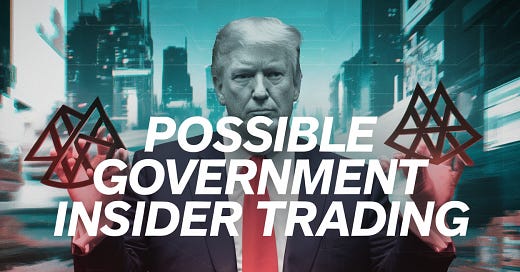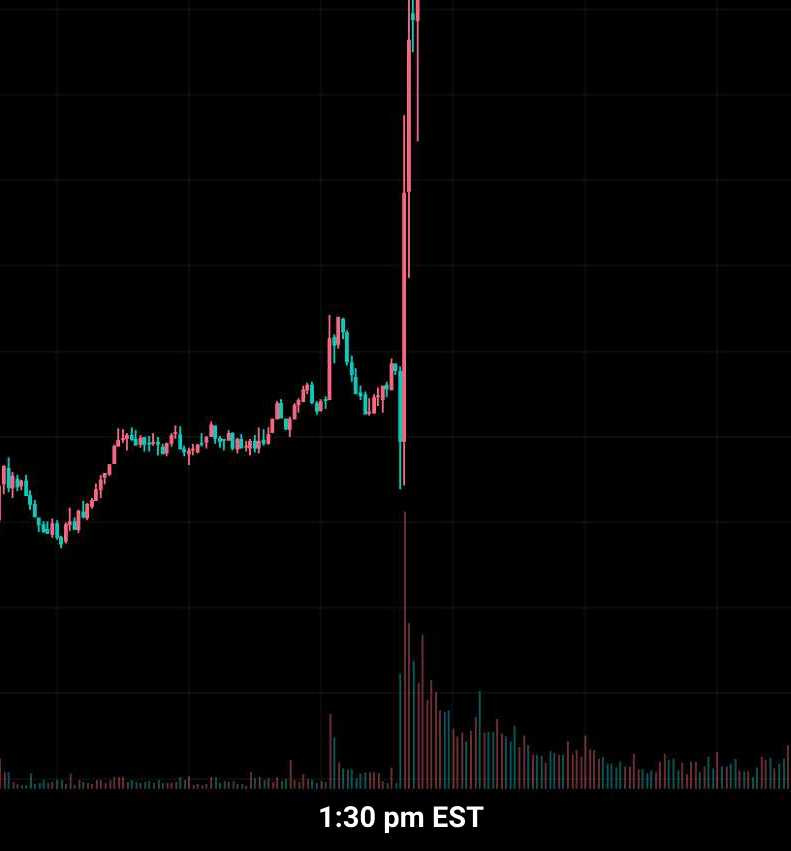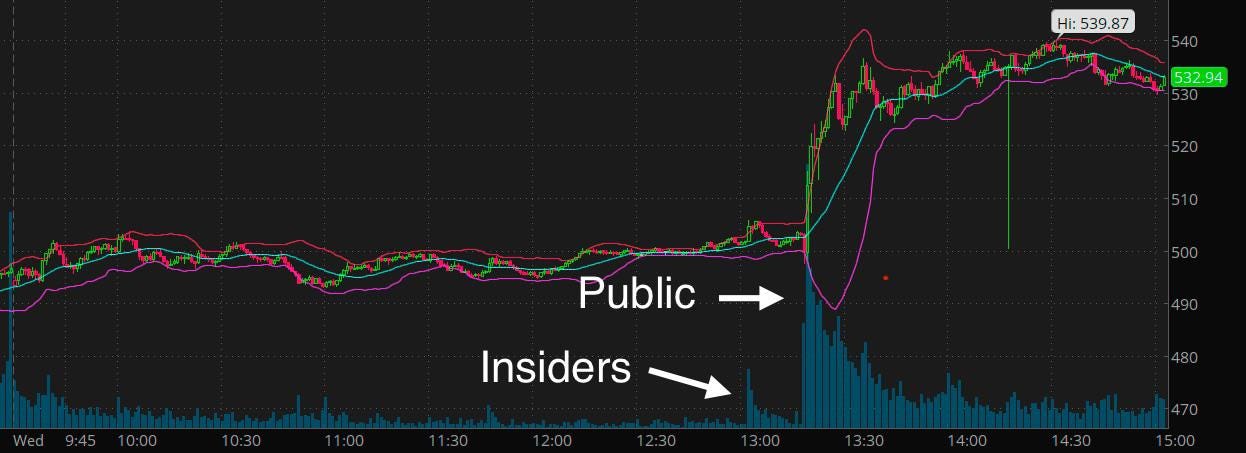⭐️ (Possible) Government Insider Trading: Profiting Billions in Minutes
Are we getting screwed?
To Smart Investors,
On April 9, 2025, financial markets experienced remarkably coordinated and precisely timed trading activities indicative of insider trading involving individuals who are likely closely linked to government entities.
Moments before President Donald Trump's significant policy announcement—temporarily halting previously implemented tariffs—traders executed massive positions that yielded exceptional profits.
These trades' remarkable precision, expansive scale, and meticulous coordination strongly suggest they acted upon privileged, non-public information, severely undermining market integrity.
Transparency and Accountability in Option Trading
Options trading and the stock market itself are inherently transparent.
Every transaction leaves a detailed record, enabling us, the market observers, to trace and analyze activities precisely.
Given this transparency, regulatory authorities have both the ability and the responsibility to investigate these events thoroughly.
Therefore, we must demand answers from regulatory bodies regarding the identities behind these suspicious trades.
It is necessary to uphold the integrity of our financial markets.
Zero-Day Options: Ideal Tools for Insider Trading
Zero-day-to-expiration (0DTE) options are financial derivatives that expire within the same trading day they are purchased.
Due to their extremely short lifespan, these options are generally inexpensive, reflecting the high probability that they will expire worthless.
However, their value can surge dramatically if a significant market event occurs within the limited timeframe before expiration.
During a crucial 33-minute window, from 12:57 p.m. to 1:30 p.m. EST on April 9, observers noted an unprecedented spike in trading volume for these typically quiet 0DTE options, especially for SPY options (tracking the S&P 500) and QQQ options (tracking the Nasdaq-100).
Notably, trading activity peaked sharply at exactly 1:02 p.m. EST—nearly half an hour before the public announcement was made:
One particularly remarkable transaction involved approximately 35,000 SPY call option contracts at a strike price of $509, purchased at just 85 cents each, despite SPY trading significantly below this strike, around $500 at the time.
Following Trump's 1:30 p.m. announcement, these options soared above $25 each, converting an initial $2.5 million investment into a staggering profit exceeding $100 million in several minutes.
Yet, this single trade represents just one component of a broader strategy.
An Extensive, Multi-Billion Dollar Coordinated Operation
Detailed analysis reveals simultaneous substantial trades across multiple SPY strike prices—$504, $505, and $507—and significant calls in QQQ options.
This systematic execution across various instruments clearly indicates strategic intent and detailed market knowledge.
Such widespread and coordinated trading considerably amplifies total potential profits, suggesting gains likely extended well beyond tens of millions into billions of dollars.
Additionally, parallel trading activity in SPY shares reinforces the coordinated strategy.
Precisely at 1:02 pm EST, about 2.75 million SPY shares traded within a single minute.
Selling these shares at the day's closing price of $534 translates to immediate profits surpassing $100 million.
Elevated trading volumes persisted for an additional fifteen minutes, suggesting total realized profits during this brief period could exceed $1.5 billion—all before most investors understood the reason behind the market's sudden surge.
Advanced Exploitation of Market Mechanics
The nature of these trades overreaches typical speculative or reactionary investments seen among retail or even institutional investors.
Instead, these transactions reveal sophisticated actors possessing expert-level financial market knowledge.
Central to this strategy was leveraging a phenomenon known as a "gamma squeeze," where market makers—initially sellers of options—are forced to hedge by purchasing substantial quantities of underlying stock as prices rise, thereby amplifying upward momentum.
The precise timing, strategic diversification across multiple strike prices, and deliberate use of market mechanics demonstrate a sophisticated understanding of the impending policy announcement, strongly indicating insider knowledge rather than mere speculation.
Historical Comparisons Confirm Insider Trading Allegations
I have access to all historical options flow, and I checked.
Comparing the April 9, 2025, events to significant historical market shocks—such as the Federal Reserve's emergency interest rate cuts in 2008, quantitative easing programs initiated in 2009, the Brexit referendum of 2016, and the COVID-19 market crash of 2020—reveals no similar pre-announcement trading patterns.
Typically, market-moving announcements prompt notable trading volume and price volatility only after information becomes public.
The absence of pre-announcement trading in these historical instances emphasizes how unprecedented the events of April 9 truly were, further reinforcing allegations of insider trading.
Given the broad coordination and scale, aggregate profits from these coordinated SPY and QQQ trades likely exceeded billions.
Such an extraordinary level of profitability and market disruption strongly suggests these actions were executed by entities with privileged, non-public information.
Immediate Regulatory Action: Essential for Market Integrity
Insider trading on this monumental scale represents not merely an ethical violation but a fundamental threat to market fairness, investor confidence, and economic stability.
If government officials or affiliates allegedly exploit confidential information for enormous financial gains, it severely erodes public trust and jeopardizes the foundational fairness crucial for robust financial markets.
Such blatant possible insider trading demands swift, rigorous regulatory scrutiny and enforcement.
Failure to promptly investigate and penalize these actions risks sending a dangerous signal, potentially destabilizing investor trust and threatening broader economic stability.
It is imperative that regulators and policymakers decisively uphold market integrity and transparency, ensuring accountability for those manipulating markets using privileged governmental information.
Which entities are responsible for regulating options trading?
🛡️ Primary Regulatory Bodies
Securities and Exchange Commission (SEC)
The SEC is the chief federal agency overseeing securities markets, including equities and equity options. It investigates insider trading and can impose civil penalties or refer cases for criminal prosecution.Commodity Futures Trading Commission (CFTC)
The CFTC regulates U.S. derivatives markets, including futures, swaps, and certain options. If the insider trading involves commodity options or swaps, the CFTC would be the relevant authority.Financial Industry Regulatory Authority (FINRA)
FINRA is a self-regulatory organization under SEC oversight. It monitors broker-dealers and trading activities, enforcing compliance with federal securities laws.
📣 Reporting Insider Trading
To report suspected insider trading:
Submit a Tip to the SEC: Use the SEC's Tips, Complaints, and Referrals (TCR) system to confidentially report violations.
Whistleblower Program: If you wish to remain anonymous and be eligible for a whistleblower award, you must be represented by an attorney when submitting your tip.
Mail or Fax: Alternatively, you can complete Form TCR and send it by mail or fax to the SEC's Office of the Whistleblower.
— Jack
P.S. Sue me







There is a paper trail for each trade. Sort by profitability and interrogate from the top down.
What an eye-opener! Jack, your analysis exposes an undeniable breach of market integrity, where precisely timed trades ahead of the President's policy shift strongly points to insider trading. You are absolutely correct that we need to demand answers. The SEC, CFTC, and FINRA must act swiftly. Failing to investigate and hold the responsible parties accountable sets a dangerous precedent—one that signals to market manipulators that these abuses are permissible.
I was genuinely surprised to read about this; I had believed that, in this new era of transparency and heightened focus on justice, such blatant manipulations might be behind us. Clearly, that was wishful thinking on my part.
You are right: we are getting screwed, or should I say that we continue to get screwed?